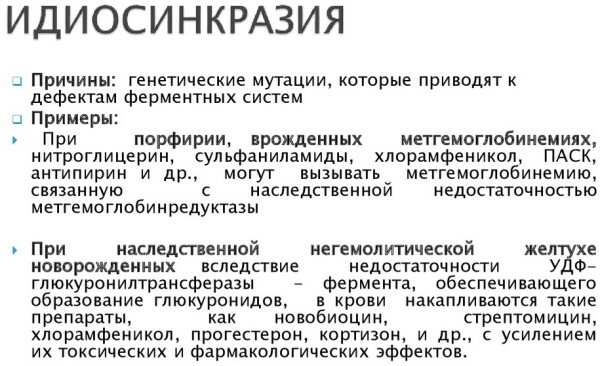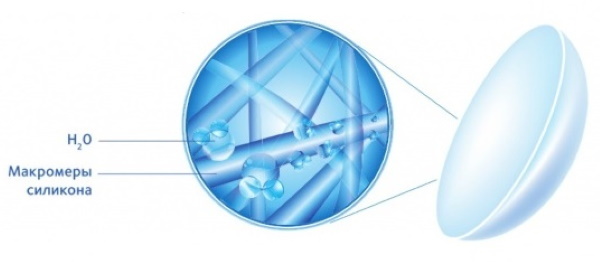Content
- Definition of what it is
- general characteristics
- Classification by causes of occurrence
- Acquired
- Hereditary
- Due to individual immunological reactivity
- Clinical manifestations
- Yodism
- Cold allergy
- Lactose intolerance
- Video about idiosyncrasy
In pharmacology, idiosyncrasy does not have a clear clinical picture, because the symptoms are established by the composition of the drug taken and the nature of the congenital gene mutation. Diagnosis of this pathology requires a detailed genetic and immunological study. To treat the problem, it is necessary to exclude interaction with the provoking antigen, as well as to use the detoxification method and appropriate drugs.
Definition of what it is
Idiosyncrasy in pharmacology is a phenomenon or an object to which a person manifests an aggravated reaction in the form of fear or irritation. In psychology, this problem is identical to an allergic reaction in medicine, since for other people, experiencing fear of a certain object or phenomenon, it will be perceived absolutely fine.
On the pharmacological side, idiosyncrasy is manifested by an allergic reaction to the intake of a certain substance. Often times, this reaction can be inherited at the genetic level.
general characteristics
Idiosyncrasy in pharmacology is not a clear-cut concept, as noted in the 1970 Great Medical Encyclopedia. Today, specialists rarely use such a vague concept. Often this reaction is called pseudoallergy or fermentopathy.
In 1960-1970, scientists have identified the main principles of the formation of allergic factors. As a result, the concepts of food and drug allergies arose. Food and drug sensitization factors are not always associated with the manifestation of a specific allergic reaction in the form of the formation of sensitized lymphocytes, or antibodies. Sometimes the reaction will not be triggered by the activity of the immune system.
Such reactions, which are manifested during the formation of mediators without the involvement of immune mechanisms, fall under the term pseudoallergy.
If, when a reaction occurs, the activity of any enzymes that accelerate chemical processes in the body is disrupted or absent, it means that fermentopathy or enzymopathy occurs.
When the body begins to come into contact with an immediate irritant, the first symptoms of idiosyncrasy come into play, manifested by high body temperature, headache and general signs of intoxication in the form of nausea and severe vomiting reflex. Swelling of the mucous membrane, skin and shortness of breath may also develop. On the skin, symptoms of urticaria appear in the form of itching and pinpoint rash. In very severe cases, eczema may develop.
Experts bring all the signs of pathology into one concept - an attack that can last for several hours or for 2 days.
Idiosyncrasy and allergic reaction are 2 different concepts. With a careful study of the principles of the appearance of a painful reaction and comparing it with an allergic reaction, similar and distinctive signs will be present. For example, symptoms of idiosyncrasy appear almost immediately when a person comes into contact with an immediate stimulus. An allergic reaction occurs after a few hours or days.
This reaction is often caused by foods such as dairy products, eggs and seafood. Also, idiosyncrasy can manifest itself with the incorrect and prolonged use of antibiotics, drugs of the sulfonamide group or amidopyrine.
Additional causes of the problem:
- an allergic reaction to bromine or iodine;
- insolation;
- hypothermia.
There are many factors that can cause a painful reaction and should be avoided. You can also perform a comprehensive diagnostic study if there is no information about the tendency to develop an allergic reaction to a medicine or food.
The primary examination should be carried out by an allergist-immunologist to exclude the anaphylactic component of the disease. In this case, the specialist must collect anamnesis, as well as determine the presence of genetic and allergic disorders in relatives. If the patient does not have symptoms of respiratory allergies or allergic dermatosis, but symptoms appear after the first use of the drug, therefore, idiosyncrasy is manifested.
As a diagnosis, the patient must pass tests and consult:
| Method | Peculiarities |
| Blood test | In the hemogram, there may be a decrease in hemoglobin values with erythrocytes, as well as deviations that are provoked by the underlying pathology. In this case, the eosinophil count will be normal. Using an immunogram, a specialist will determine the content of class E antibodies, as well as the absence of special immunoglobulins. |
| Genetic consultation | The patient must be examined by a geneticist to identify the burdened heredity. This is due to the fact that idiosyncrasy has pronounced metabolic dysfunctions. To confirm the diagnosis, molecular genetic research is required, as well as the method of liquid or gas chromatography to study the index of metabolites in urine and blood. |
The patient should immediately stop contact with the medication that is causing the symptoms. Since endotoxicosis can develop and drug deformation of internal organs can occur, an infusion of crystalloid solutions is required, which performs the function of detoxification. To stop hyperactivity, you need antihistamines with mast cell stabilizers.
If drug hepatopathies often occur with idiosyncrasy, L-carnitine and N-acetylcysteine should act as nonspecific antidotes. Glucocorticoids are required for severe systemic reactions.
Full recovery will be determined by the severity of the pathology, the presence of genetic diseases and the initial state of health. The process can be quickly stopped if moderate pseudo-allergic symptoms are present. The prognosis will be doubtful if the state of health sharply worsens and the congenital disease worsens, because damage to internal organs in rare cases can end in death.
Classification by causes of occurrence
In pharmacology, congenital and acquired idiosyncrasies are distinguished. They are difficult to treat because they are triggered by poisoning. For example, with the toxic effects of Rusa toxicodendron, even if the interaction has passed with the skin, the body will be too sensitive to this plant.
As a result, when a person passes near him, after a few days he will turn to a specialist with signs of poisoning. If idiosyncrasy is acquired, after 1 dose of the drug, the problem will completely disappear. If the reaction is congenital, the drug can only relieve the symptoms, but not permanently fix the problem.
Congenital pathology to a certain object or phenomenon will remain until the end of life. To reduce the force of its occurrence, it is necessary to take antipsoric drugs that affect the source of painful conditions.
Acquired
Idiosyncrasy in pharmacology can be an acquired reaction that appears throughout life under the influence of various factors in the form of pathologies, starvation, hypovitaminosis.

Factors affecting the appearance of acquired reactions:
- lack of conferences arising from the disorder of ion exchange, vitamin deficiency and hypovitaminosis;
- synthesizing dysfunction of the protein part of the enzyme caused by a lack of amino acids, energy and protein starvation;
- accumulation in the body of components that suppress the production of enzymes.
Sometimes in children and adults, the reaction occurs as a pathology, for example, diabetes mellitus, albinism. In adults, idiosyncrasy can reduce the protective properties of the body, making it sensitive to various pathological changes.
Hereditary
Hereditary idiosyncrasy is triggered by a genetic defect and occurs almost immediately from the moment of birth. It appears due to mutation of gene structures. For example, people will be more sensitive to everything: bright lighting, taste, smells. This is considered a congenital abnormality.
For some people, sensitivity to certain things will arise only after taking them in a potentiated state. For example, the patient eats large amounts of table salt, salty food, and also dissolves salt crystals. This happens when the body is deficient in this substance.
However, coarse salt will not be perceived, as a result, a person gets sick and loses weight. When a small volume of salt is prescribed to the patient, there will initially be an increased primary deterioration, then the stage of recovery begins, and the person loses the desire to eat salt and a large amount of salty food.
A hereditary reaction can occur immediately after birth or during the first years of life, everything will depend on the severity of pathological changes. However, with the early onset of clinical symptoms in children, the reaction will be difficult.
If the hereditary form of pathology is severe, after birth the child will initially be healthy, but after a few days the first nonspecific signs of the problem will begin to appear. The child may suffer from seizures, constantly regurgitate, poorly suckle, or be inhibited.
Signs of idiosyncrasy regarding a lack of certain enzymes may include:
- skeletal anomaly;
- diarrhea with flatulence;
- dysfunction of consciousness;
- jaundice, enlarged liver;
- delayed intellectual development;
- a specific unpleasant odor emanates from the child, for example, mice, mold, rotten fish or boiled cabbage;
- clouding of the cornea;
- disorder of vision, hearing;
- muscle weakness;
- skin rash;
- chronic gag reflex.
Due to individual immunological reactivity
Immunological reactivity is the body's ability to respond to antigen exposure with humoral and cellular responses.
This ability is explained by the presence of 2 types of immune cells:
- T-lymphocytes, which directly react with the antigen and carry out immune responses at the cellular level;
- B-lymphocytes, which are converted under the influence of antigens into plasma cells that produce immunoglobulins, which are responsible for the humoral immune response.
These types of immune cells have specific receptors that are able to recognize antigens.
Clinical manifestations
Idiosyncrasy in pharmacology is a reaction that often manifests itself to iodine, hypothermia and the intake of dairy products. Also, hypersensitivity can occur after the consumption of certain food ingredients or medicinal formulations. Any irritant must be identified in time so as not to aggravate the state of the body and health in general.
Yodism
The reaction to iodine can be manifested by sneezing, lacrimation, increased runny nose when interacting with an irritant and itching of the facial area. An allergic reaction can manifest itself on an iodine solution for external use, drugs in which iodine is present, as well as on iodized salt.
To eliminate intolerance, it will be necessary to establish an irritant. Due to the fact that the reaction appears almost immediately, this is very easy to accomplish. It is enough to exclude contact with the irritant by replacing the means taken, as well as deleting unsuitable delicacies from the menu.
Antihistamines can help manage an attack. The specialist will prescribe the appropriate medication and dosage. Since the attack can appear suddenly, it is recommended to always take the drug with you.
Cold allergy
Abnormal cold snap sensitivity is not a direct allergic reaction. This requires a component foreign to the body that elicits an enhanced response from the immune system.
However, the symptoms that appear when interacting with a cold object or air will coincide with the allergic one. In this case, anaphylactic shock, Quincke's edema or urticaria may occur. In this regard, this condition belongs to the allergic group, which is provoked by physical factors. Allergists-immunologists are involved in the treatment.
Often, the disease is manifested by cold urticaria, which does not differ from ordinary urticaria: there is swelling, the skin swells, turns red, blisters appear with blisters, which can be supplemented itching.
When the interaction with the cold is stopped, all symptoms will go away without therapy. However, in some cases, sensitivity can increase and spread throughout the body, provoking anaphylactic shock.
An allergic reaction to cold can occur during the summer season. To do this, a person only needs to eat ice cream or drink soft drinks.
Lactose intolerance
If there are not enough enzymes in the intestines, lactose intolerance manifests itself. In this regard, lactose is not able to further break down into galactose and glucose. If the pathology is not detected in a timely manner in a small child, dysbiosis may occur.
The main signs of a problem in childhood are the following:
- loose stools occur;
- an infant refuses dairy products;
- vomit.
However, the listed symptoms can occur with an infectious disease. In this regard, it is necessary to correctly establish the diagnosis.

To define idiosyncrasy, you must:
- exclude dairy products from the menu for 10 days;
- monitor the child's reaction during this period;
- after 10 days add milk mixtures to the diet.
If the loose stools persist, then the child is lactose intolerant. To solve the problem from the children's diet, it is necessary to exclude milk formulas by using vegetables with fish. It is also recommended to cook rice porridge, boiled in water.
Pharmacological prevention of idiosyncrasy implies a competent approach to the choice of drug treatment in patients with congenital fermentopathy. The treatment of this problem should be dealt with by a specialized specialist with a clinical pharmacologist and a geneticist, excluding the use of toxic drugs. Patients must definitely monitor their well-being at the stage of therapy and seek help in case of atypical symptoms.
Video about idiosyncrasy
Idiosyncrasy - which means:



